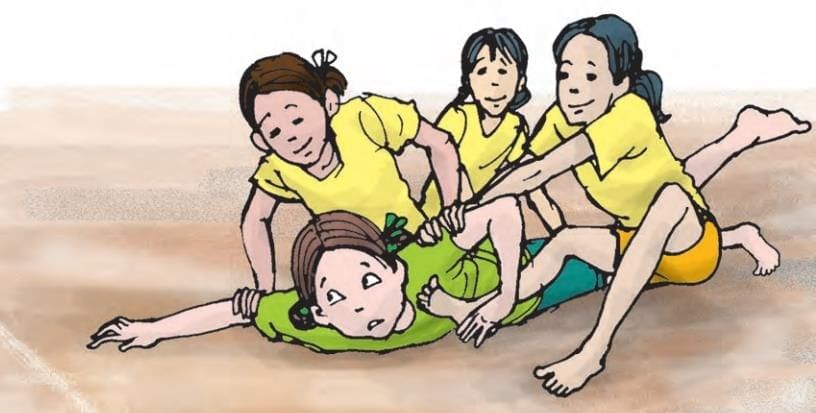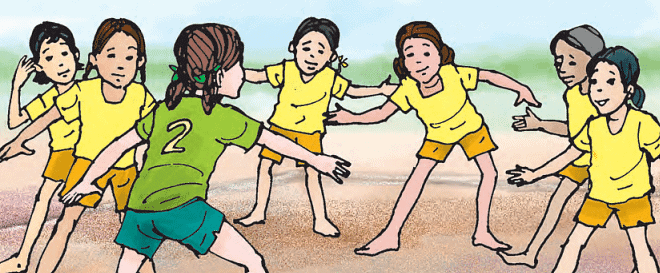Hu Tu Tu, Hu Tu Tu - 1 Class 4 Worksheet EVS Chapter 10
Q1: Fill in the Blanks
(i) Karnam Malleshwari can lift a weight of _____ kilograms.
Ans: Karnam Malleshwari can lift a weight of 130 kilograms.
(ii) Both mind and _____ are used in kabaddi.
Ans: Both mind and body are used in kabaddi.
(iii) Shyamala managed to touch the line despite being ____ by the other team.
Ans: Shyamala managed to touch the line despite being caught by the other team.
(iv) Every game is played according to some _____.
Ans: Every game is played according to some rules.
(v) Kabaddi is a _____ but fun game with many rules.
Ans: Kabaddi is a rough but fun game with many rules.
Q2: True and False
(i) Heera is a Kabaddi coach.
Ans: True
(ii) Leela and Heera have founded a kabaddi club.
Ans: True
(iii) The chapter does not highlight the struggles of Jwala, Heera and Leela
Ans: False
(iv) Karnam Malleshwari has 3 sisters.
Ans: False
Karnam Malleshwari has 4 sisters. Hence, the given statement is false.
(v) Kabaddi involves a bat and a racquet.
Ans: False
Kabaddi does not involve a bat and a racquet.
Q3: Short Answer Questions
(i) Why did people discourage the 3 sisters from playing kabaddi?
Ans: The people discouraged the 3 sisters from playing kabaddi, fearing that nobody would marry them. Also, they said that the girls would have to wear clothes like boys.
(ii) Which sister decided to become a kabaddi coach?
Ans: Heera, the youngest sister, decided to become a kabaddi coach.
(iii) List some games similar to kabaddi.
Ans: The following are the games Similar to Kabaddi:
- KhoKho
- Langdi Tang
- Gilli Danda
- Kancha
(iv) Tell the name of the three sisters that this chapter revolves around.
Ans: Jwala, Heera and Leela
(v) What are some other names by which the game of Kabaddi is called?
Ans: Kabaddi is called by names like Chedduguddu, Hu-tu-tu, Choo Kit Kit and Ha-du-du.
(vi) Identify the Athlete Ans: The name of the athlete is Karnam Maleshwari.
Ans: The name of the athlete is Karnam Maleshwari.
(vii) How does a coach help a player?
Ans: A coach improves their athlete's motivation to achieve and the enjoyment they receive from participation in the game. A coach acts as a teacher, organiser and a leader.
(viii) What activities are involved in playing kabaddi?
Ans: Kabaddi involves pushing and pulling, screaming and shouting, and dragging and falling on the ground. It includes running and continuously saying Kabaddi-Kabaddi and trying to touch the players of the opposite team.
(ix) How can one get out in Kabaddi?
Ans: There are three ways to get out in Kabaddi:
- If he is stopped by the opposition players while on his move. (Raider is out)
- If he loses breath. (Raider is out)
- If he touches an opposition player, and the opposition team cannot stop him.(Player in defending team is out)
(x) What do the Kabaddi players chant while playing Kabaddi?
Ans: Kabaddi players chant “Kabaddi Kabaddi” while playing it.
|
49 videos|217 docs|54 tests
|
FAQs on Hu Tu Tu, Hu Tu Tu - 1 Class 4 Worksheet EVS Chapter 10
| 1. What is the meaning of the title "Hu Tu Tu"? |  |
| 2. What is the target audience for the article "Hu Tu Tu"? |  |
| 3. How does the article describe the complexity of the questions and answers? |  |
| 4. Are there any specific guidelines for formulating the Frequently Asked Questions (FAQs)? |  |
| 5. What is the purpose of including Frequently Asked Questions (FAQs) in the worksheet? |  |





















